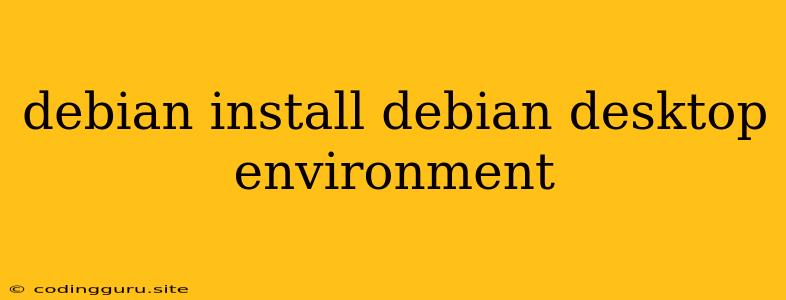A Comprehensive Guide to Installing a Debian Desktop Environment
Debian is a popular and highly versatile Linux distribution known for its stability and security. While Debian is often associated with server environments, it also offers a robust desktop experience through its wide selection of desktop environments. This guide will walk you through the process of installing a Debian desktop environment, helping you transform your Debian system into a user-friendly workstation.
Why Choose a Debian Desktop Environment?
You might be wondering why you'd choose to install a desktop environment on your Debian system. Here's why it's a good idea:
- User-Friendly Interface: Desktop environments provide a graphical user interface (GUI) that makes navigating and interacting with your computer much easier.
- Applications & Features: Desktop environments come bundled with essential applications like web browsers, office suites, media players, and more.
- Customization: You can personalize your desktop environment with different themes, wallpapers, and layouts to match your preferences.
- Performance: Modern desktop environments are optimized for performance and resource efficiency, providing a smooth user experience.
Popular Debian Desktop Environments
Before diving into the installation process, let's explore some popular Debian desktop environments to find the best fit for your needs:
- GNOME: A well-established and highly customizable desktop environment known for its clean and modern interface.
- KDE Plasma: A visually appealing desktop environment packed with features and customization options.
- Xfce: A lightweight and fast desktop environment ideal for older or resource-constrained machines.
- Cinnamon: A visually attractive and feature-rich desktop environment based on GNOME but with a more traditional feel.
- LXDE: An extremely lightweight desktop environment perfect for minimal systems with limited resources.
Step-by-Step Installation Guide
This guide will focus on installing the GNOME desktop environment. The process for other environments is similar but may have slight variations.
1. Boot from the Debian Installation Media:
- Download the latest Debian ISO image from the official Debian website.
- Create a bootable USB drive or DVD using a tool like Rufus or Etcher.
- Boot your computer from the USB drive or DVD.
2. Select Install Debian:
- Choose "Install Debian" from the boot menu.
- Select your language and keyboard layout.
3. Network Configuration:
- Connect your computer to the internet.
- If necessary, manually configure your network settings.
4. Disk Partitioning:
- Choose your partitioning scheme (e.g., Guided - use entire disk, Manual).
- Be cautious during partitioning as it involves modifying your hard drive.
- If you're unsure, choose the Guided option for simplicity.
5. Base System Installation:
- Select your time zone and mirror server.
- Choose your root password and a user account.
- Select your desired desktop environment (GNOME in this case).
6. Complete Installation:
- Confirm your selections and begin the installation process.
- The installation may take some time depending on your system's speed and network connectivity.
7. Reboot and Login:
- Once the installation is complete, reboot your system.
- Log in to your newly created user account.
8. Explore Your Desktop Environment:
- Familiarize yourself with the GNOME desktop.
- Explore the application menu, system settings, and other key features.
9. Install Additional Software:
- Use the "Software & Updates" application to install additional software.
- Consider installing essential applications like a web browser, office suite, and media player.
Post-Installation Tips
- Update your system: After installation, it's crucial to update your system to ensure you have the latest security patches and software updates. Use the command
sudo apt update && sudo apt upgrade. - Install additional applications: Explore the vast Debian package repository and install any other software you need. Use the
aptcommand to install packages, for example,sudo apt install firefox. - Customize your desktop: Change your wallpaper, theme, and other settings to personalize your desktop environment.
- Explore GNOME Shell Extensions: Add extra features and functionality to your GNOME desktop by installing extensions from the GNOME Shell Extensions website.
Troubleshooting
If you encounter any problems during the installation process or after installation, here are some troubleshooting tips:
- Check the Debian documentation: The official Debian documentation offers detailed information on installation, configuration, and troubleshooting.
- Use the Debian forum: The Debian forum is a valuable resource for getting help from experienced Debian users.
- Search online: Many tutorials and articles cover common issues and solutions.
Conclusion
Installing a Debian desktop environment can transform your Debian system into a powerful and customizable workstation. With a wide selection of desktop environments to choose from, you can find the perfect fit for your needs and preferences. By following the steps outlined in this guide, you can easily install and set up a Debian desktop, unlocking a world of possibilities for your computing experience.
